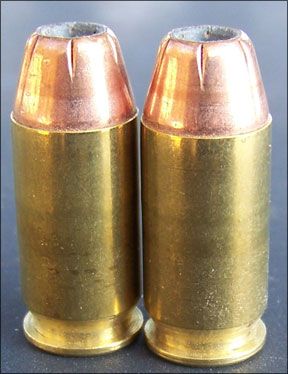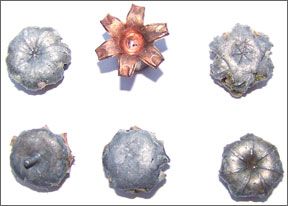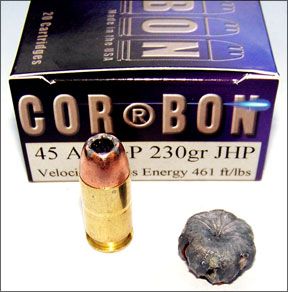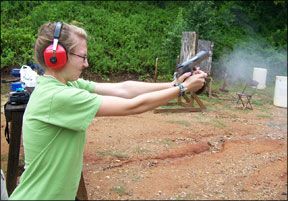When the debate turns to small and large calibers and high velocity versus a big bullet, we tend to yawn. Been there, done that, and shot lots of game. Studied plenty of personal-defense shootings as well. We are often consulted by the crime-scene team in one of the busiest areas in a high-crime area in the Southeast. We have not seen it all, but we have a good idea of what occurs when a bullet meets a threat or a game animal. We prefer the big-bore cartridge. The slow and heavy 230-grain 45 ACP has exhibited excellent results and proven consistently effective over the course of 100 years. We feel that handgun selection and marksmanship are most important. More time in training and less agonizing over the load would be beneficial.

Many view load selection as critical. We agree, but for different reasons that some assume. Reliability is a million times more important than a perceived difference in terminal ballistics.
While big-bore cartridges are proven, all poor results do not come from small bores. There have been occasional failures with big-bore cartridges, largely through misapplication. One of our researchers has seen quite a bit of action and investigated a number of shootings. He is quick to point out that when a peace officer tells us he has seen something, he means he arrived just after the action was over. However, he has also seen the effect of the 45 ACP over his own sights and debriefed many others who have been involved in critical incidents. Sometimes a felon does not even register that he has been shot. This rater also mentions a rather dramatic failure he personally experienced (1984) when a very popular factory-produced 200-grain jacketed hollowpoint dramatically under penetrated. As he points out, this load was the darling of the popular press, but it expanded to nearly 1 inch and stopped in less than 3 inches of bone and muscle!
Speed is not the whole picture. Some 45 ACP loads show all the velocity we could ask for. These are the +P-rated loadings. +P means higher pressure, and the loads are several steps above the norm. Rather than the standard 18,000 psi of the 45 ACP, the +P load will average 21,000 to 22,000 psi.
In examining this +P class of ammunition, we wished to answer two questions: Does the +P offer improved performance?, and Which are the best examples? Since we began with the premise that the standard-velocity 45 has good wound potential, the high-velocity loads would have to offer a significant advantage. The standard 45 loads offer good control and excellent accuracy in quality handguns. If a high-velocity load affects the control of a handgun—or it is not accurate—there is little point in adopting such a load.

Our test +P samples included three Cor-Bon jacketed hollowpoint loads: 165-, 185-, and 230-grain Self-Defense JHP loads No. SD45165, No. SD45185, and No. SD45230, respectively. All sold for $29.48/20 on the company’s retail website. We also shot the all-copper 185-grain DPX load from Cor-Bon, DPX45185, $40.94/20. And the fifth Cor-Bon load was the PowRBall 165-grain load No. PB45165, $30.14/20. Remington’s entry was a 185-grain Golden Sabre +P brass-jacketed hollowpoint load, GS45ACP, $26.79/25. From Speer we shot a 200-grain Gold Dot load No. 23969, $23.99/20, which was out of stock at Midway until mid-April. From Black Hills, we shot one 230-grain +P load, D45N6, $49.99/50; and one standard-pressure load, D45NS, $46.99/50, as a reference round.
We also shot two rounds that have become discontinued during our test period. Federal’s LE-marked Premium 185-grain HydraShok P45HS2G is no longer listed on the Federal website, and various retailers said it had been discontinued. We did find some selling for $35/50 at www.ammoman.com, but we can’t guarantee future supplies. And according to the Midway website, the Winchester 230-grain SXT (Supreme Expansion Technology) round has now been discontinued. Ours was $25.49/20 when it was still available.
We originally tested the ammunition in two handguns. The primary handguns used are representative of the 1911 breed, a Smith & Wesson SW1911 and a Kimber Gold Combat—one service gun and one top-end 1911 made for depth and breadth. Here’s what we found:
Function
+P loads may accelerate slide velocity and limit the ability of the handgun to feed. The magazine may not be able to catch up with the increased slide velocity. Although we often use Chip McCormick, Metalform, and Wilson Combat magazines for convenience in long-term testing, we felt that it was best to rely upon the original factory magazine in order to qualify reliability. There was no single reliability stage in which we simply fired 50 rounds of each load in each handgun during the recoil control, accuracy and ballistics testing stage. This is 1,000 rounds total. There were no failures to feed, chamber fire or eject. We feel that the good reliability of the cartridges tested is due partly to the fact that almost all kept the overall length of the cartridge to the magic 1.220 to 1.250 inch overall length needed to ensure reliability in the controlled-feed 1911 handgun.
Also, the Cor-Bon loads all incorporate a cannelure in the cartridge case to prevent the bullet from backing into the case as it contacts the feed ramp. We feel that this is important. It is essential that the bullet meet the feed ramp and snug up against the breech face and extractor in the 1911 design. The Federal and Speer loads also used this cannelure. The others did not. Each cartridge passed a test of having a single example chambered ten times without backing up into the case. Case mouth seal and a good friction fit are used. Just the same we like the cannelure.
The number of rounds fired is a small sample in the life of a handgun that is capable of digesting 50,000 standard pressure loads. Still, this is a sizable number of +P loads. There was no hint of eccentric wear, no peening of the slide lock notch, no looseness in the plunger tube, and no loose sight screws. The grip screws of the Smith & Wesson worked loose. We feel the loose screws were a product of the hammering of the +P loads. The recoil and magazine springs were as strong as when the test began. Extractor tension had not changed.
Rating Recoil

The recoil of a +P load is noticeable compared to a standard-pressure loading. This level of recoil makes control more difficult. The cadence of fire is not set by how quickly you are able to press the trigger but by how quickly you are able to recover the sight picture in recoil. There is no question that it is more difficult to control the heavier loads. This makes one question whether a +P load is a good choice for personal defense. Handguns lighter than our test pistols would be difficult to handle, and short-barrel pistols would lose velocity in comparison. The 5-inch steel-frame 1911 is the natural home of +P loads. We used the power factor to calculate recoil energy, multiplying the weight of the bullet by velocity. We also rated the cartridges subjectively. Some raters barely noticed +P recoil after firing standard velocity loads for practice. Others found +P loads startling. Most felt that recoil was controllable but that you would not fire 100 rounds of +P in a session as you do standard loads. The 185-grain loads are rule beaters of a sort, offering a PF similar to a standard pressure 230-grain load but with high velocity.
In the end the verdict is conclusive: +P loads are more difficult to control. A subjective consensus is that if you deploy +P loads, you need to practice 25% more for the same level of control enjoyed with standard pressure loads.
Comments on SD and Accuracy
The ammunition companies know they have to pay attention to detail in what is basically an overload. These loads showed a low extreme spread and a very low standard deviation of velocity between shots. Several loads exhibited an ES of less than 30 and an average SD of 12. That is very consistent. Accuracy was excellent. We did take more time to adjust after each shot in firing for accuracy, especially with the harder kicking 230-grain loads.
Gun Tests Report Card: Grade A Loads
Speer Gold Dot 200-grain No. 23969, $23.99/20. This is our No. 1 pick among the lower-weight bullets. The Federal load expanded less than the Remington while the Remington penetrated less. A toss up we have to say. We feel the 200-grain Gold Dot bullet pushes them aside in performance with equal penetration in comparison to either and practically the same expansion as the Golden Saber, but with a heavier bullet. The Gold Dot also edges either out in accuracy. While the power factor rating appears only slightly less on paper, all raters noted that the Speer load seemed mild to fire. Perhaps a particularly efficient powder blend would be the answer. In any case, the heavier bullet won out among the light weight bullets. But is the Speer Gold Dot +P worth the extra money? We wonder. The Gold Dot does not quite equal the penetration performance of the standard pressure Black Hills 230-grain JHP, (13.5 inches vs. 13.0 inches) with both expanding to a 0.72-inch slug. On price, the standard pressure round wins out, shooting for 94 cents a shot compared to $1.20 a shot for the Speer. Our view: There’s no point in adopting a loading with +P pressure without greater performance.
Cor-Bon Self-Defense JHP 230-grain SD45230, $29.48/20. The Cor-Bon 230-grain +P is Cor-Bon’s answer to the need for a heavier bullet for law enforcement use and for use against felons who may be heavily clothed. The Cor-Bon has a slight advantage in penetration over the Winchester SXT,

with virtually the same expansion. The Cor-Bon load has slightly more penetration and accuracy is very close with either. Downside: The Cor-Bon has more recoil by several points. Let’s compare them to the standard pressure benchmark load: Cor-Bon 230-grain JHP, 13.5 penetration, 0.75 expansion; Black Hills 230-grain JHP, 13.5 penetration, 0.72 expansion. Looking at it this way, the Cor-Bon load has the edge. There is actual improvement over the standard pressure load. Is it worthwhile? Since we use water and calculations for test media—and we venture into speculation—we cannot tell at what point the Gold Dot bullet reaches its 0.75 expanded diameter. There is a good chance the Cor-Bon load began to expand more quickly due to its almost 80 fps advantage over the standard-pressure load. The Cor-Bon 230 is at the top of the heap by a small margin.
Next, we compare the Cor-Bon 230-grain bullet to the Black Hills +P. Black Hills uses the Gold Dot bullet in its standard-pressure loads but is free to pick and choose any bullet, giving great versatility. The Hornady 230-grain XTP was chosen for the +P loading. There are those who demand a maximum of penetration. For hunting use the XTP bullet is clearly the superior choice. At this point it is about design and expectation.
The Black Hills load has a well-defined advantage in penetration. Personal experience indicates the advantage may be even greater in the case of thin-skinned game animals. The Black Hills load is more accurate, but the call is close and the situation may be reversed in the next pair of handguns. We declare a tie for first place. The Cor-Bon load would be more suitable as a personal-defense loading for most of us. The Black Hills load would be the outdoors load and the load of choice in a true four season climate where felons might be heavily bundled during the winter months.
Black Hills 230-grain +P D45N6, $49.99/50. This load was once advertised as the Mack truck of 45 ACP loads. The Black Hills load is designed to offer maximum penetration (13.5 inches, with 0.72 inch expansion) with the Hornady XTP bullet. The Black Hills load showed the most penetration of any load tested and the best accuracy. It fared very well compared to the Winchester 230-grain SXT, which had 13.0 penetration and 0.75 expansion readings.
Gun Tests Report Card: Grade B Loads
We were able to eliminate every load that did not reach our 12-inch penetration criteria. Some may feel this is harsh, particularly in light of the almost ideal performance of the Cor-Bon DPX load. But we set this bar some time ago and cannot lower it now. There were no malfunctions or accuracy problems. Additional loads that met our penetration requirements were: Federal Premium 185-grain HydraShok P45HS2G, $35/50; and Remington Golden Sabre 185-grain GS45ACP, $26.79/25. The HydraShok 185 gets moved down a grade because it’s no longer cataloged.
Remington Golden Sabre 185-grain GS45ACP, $26.79/25. The Golden Saber has a reputation for perfect feed reliability in all handguns. This is a credible loading—loaded fast but not too hot.
Gun Tests Report Card: Grade C Loads
Some of the loads did not meet our criteria for a minimum of 12 inches of penetration in a ballistic simulation, correlated by shooting water and calculating its performance in gelatin. They were not designed to meet our criteria or the FBI criteria in these cases, but they do what they were designed to do. Whether those design parameters meet your needs, you can decide.
Cor-Bon Self-Defense JHP 165-grain SD45165, $29.48/20. This load is designed to fragment and offer minimal penetration. It met its design parameters.
Cor-Bon PowRBall 165-grain PB45165, $30.14/20. This bullet is designed to feed in any handgun. The wide hollowpoint features a polymer ball that instigates expansion when the bullet strikes a target. It will feed in GI guns with GI magazines.
Cor-Bon Self-Defense JHP 185-grain SD45185, $29.48/20. This is the original flagship of the Cor-Bon line but now it uses the Speer Gold Dot bonded core bullet. In our opinion performance is enhanced. The single greatest expansion of any load.
Cor-Bon DPX 185-grain DPX45185, $40.94/20.
This load uses the Barnes solid copper bullet. The balance of expansion and penetration is good and recoil the most controllable of the 185-grain loads.
Federal Premium 185-grain HydraShok P45HS2G, $35/50. The Federal 185-grain HydraShok +P is a little-known loading that uses a controlled expansion bullet. Penetration is on a level with 230-grain loads. Availability may be an issue, so it gets moved down.
Winchester SXT 230-grain, $25.49/20. This is a purpose designed +P originally specifically intended to get the 45 ACP back up to full velocity when fired from a compact handgun. The typical 870 fps 230-grain JHP will fall to 780 fps from a 4- or 4.25- inch barrel. An agency using the SXT and the SIG P 220 requested this load. As might be expected from a load designed for efficiency in short barrel handguns the SXT exhibited a full powder burn and low muzzle flash.
This is a great load, and if we didn’t have worries about being able to find it in the future, it would have been A-ranked.





























